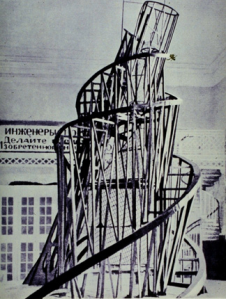Russian Constructivism
Russian constructivism was an art movement active between 1913 to the 1940s. Although the movement was created by the Russian avant-garde, it spread throughout the rest of the european continent. Constructivism is based around abstraction and focuses on experimentation and geometric themes. These constructivist themes are often quite minimal, the art is broken down to its most basic elements.
Th movement was inspired by ideas from Cubism, Suprematism and Futurism, but overall was an entirely new approach to making objects, one which sought to abolish the traditional artistic concern with composition, and replace it with ‘construction.’
Objects were to be created not to express beauty, or the artist’s outlook, but to carry out a fundamental analysis of the materials and forms of art, one which might lead to the design of functional objects. They aimed to demonstrate how materials behaved and also they goal to develop a new form of art more appropriate to the democratic and modernising factors of the Russian Revolution.
New media was often used in the creation of works as it helped to produce a sort of art that was orderly. This was a desirable factor at the time, straight after the end of world war 1 the movement was created and a sort of order was desirable at the time due to a need for understanding, unity and peace.
Famous artists of the Constructivist movement include Vladimir Tatlin, Kasimir Malevich, Alexandra Exter, Robert Adams, and El Lissitzky.
Tatlin was most famous for his Constructivist tower which was to be built from industrial materials: iron, glass and steel. It was envisaged as a towering symbol of modernity. It would have dwarfed the Eiffel Tower in Paris. Visitors would be transported with the aid of various mechanical devices. The main framework would contain four large suspended geometric structures. These structures would rotate at different rates of speed. Even if the gigantic amount of required steel had been available in bankrupt post-revolutionary Russia, in the context of housing shortages and political turmoil, there are serious doubts about its structural practicality.
Kazimir Malevich worked in a variety of styles, but he is mostly known for his contribution to the formation of a true Russian avant-garde post-World War I through his own unique philosophy of perception and painting, which he termed Suprematism. He invented this term because, ultimately, he believed that art should transcend subject matter – the shape and color should reign ‘supreme’ over the image or narrative. This was on of the fundemental ideas of the movement in that the purpose/ emotional content of a piece did not matter but instead the practicality of the piece.
Aleksandra Ekster also known as Alexandra Exter, was a Russian-French painter (Cubo-Futurist, Suprematist, Constructivist) and designer, as well as a major influencer of the Art Deco movement. In 1919 together with other avant-garde artists Kliment Red’ko and Nina Genke-Meller she decorated the streets and squares of Kiev and Odessa in abstract style for Revolution Festivities. She also worked with Vadym Meller as a costume designer in a ballet studio of the dancer Bronislava Nijinska. All of Ekster’s works, no matter the medium, stick to her distinct style. Her works are vibrant, playful, dramatic, and theatrical in composition, subject matter, and colour.
El Lissitzky was a Russian artist, designer, photographer, typographer, polemicist and architect. He was an important figure of the Russian Avant Garde, helping to develop suprematism with his mentor, Kazimir Malevich, and designing exhibition displays and propaganda works for the Soviet Union. His work influenced the Bauhaus and constructivist movements.
Vladimir Tatlin was crucially influenced by Pablo Picasso’s cubist constructions (Construction 1914) which he saw in Picasso’s studio in Paris in 1913. These were three-dimensional still lifes made of scrap materials. Tatlin began to make his own but they were completely abstract and made of industrial materials. Until then he had been inspired by Russian icons and Cézanne but his discovery of Picasso’s collages and assemblages induced him to turn towards the new territory of construction. Picasso was in fact not interested in the importance of construction, which was sufficient in itself, and concentrated his attention above all in the still lifes that were created through such process.






















